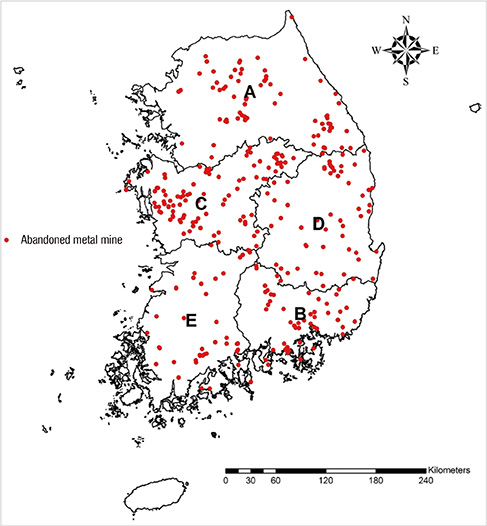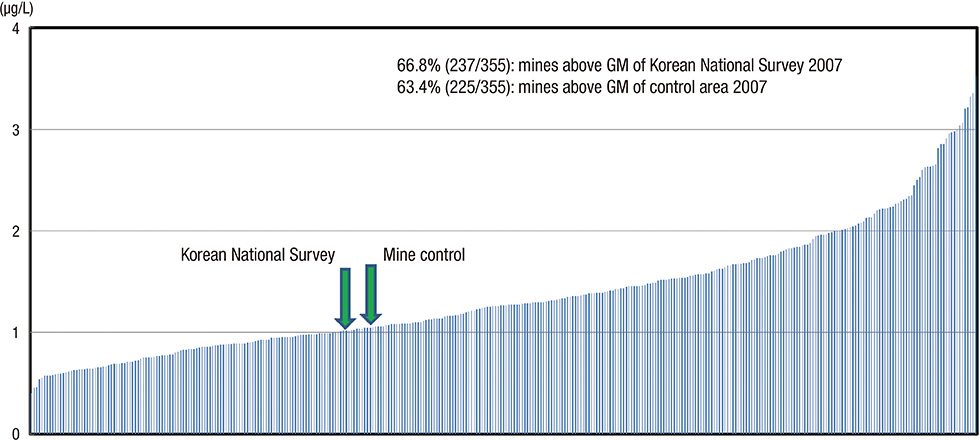J Korean Med Sci.
2014 May;29(5):633-639. 10.3346/jkms.2014.29.5.633.
Blood Cadmium Concentration of Residents Living near Abandoned Metal Mines in Korea
- Affiliations
-
- 1Department of Preventive Medicine, College of Medicine, Dong-A University, Busan, Korea. medikim@dau.ac.kr
- 2Heavy Metal Exposure Environmental Health Center, Dong-A University, Busan, Korea.
- 3Institute of Environmental and Occupational Medicine, College of Medicine, Soonchunhyang University, Asan, Korea.
- 4Department of Preventive Medicine, College of Medicine, Chung-Ang University, Seoul, Korea.
- 5Department of Preventive Medicine, College of Medicine, Yeungnam University, Daegu, Korea.
- 6Department of Preventive Medicine, College of Medicine, Korea University, Seoul, Korea.
- 7Department of Preventive and Occupational Medicine, Chonnam National University Hwasun Hospital, Hwasun, Korea.
- 8Department of Environmental Health Research, National Institute of Environmental Research, Incheon, Korea.
- KMID: 1786102
- DOI: http://doi.org/10.3346/jkms.2014.29.5.633
Abstract
- The purpose of this study was to investigate demographic and lifestyle variables and blood cadmium concentrations in residents living near abandoned metal mines in Korea. Blood cadmium concentrations were measured in 15,161 subjects living around abandoned metal mines (exposed group, n = 14,464) and compared with those living in designated control areas (control group, n = 697). A questionnaire was provided to all subjects to determine age, gender, mine working history, times of residence, smoking habits and dietary water type. The geometric mean (95% confidence intervals) of blood cadmium concentration (1.25 [1.24-1.27] microg/L) in the exposed group was significantly higher than in the control group (1.17 [1.13-1.22] microg/L). Mean residence time and mine working history in the exposed group were significantly higher than in the control group. Blood cadmium concentrations increased with increasing age, and residence time in both groups, and blood cadmium concentrations were higher in current-smokers than in non-smokers in both groups. This study shows the geometric mean of blood cadmium concentration in abandoned mining areas are higher than in non-mining areas in the general adult Korean population.
Keyword
MeSH Terms
Figure
Reference
-
1. Ministry of Environment (Korea). White paper of environment 2009. Gwacheon: Ministry of Environment;2010.2. Yang JE, Skousen JG, Ok YS, Yoo KY, Kim HJ. Reclamation of abandoned coal mine waste in Korea using lime cake byproducts. Mine Water Environ. 2006; 25:227–232.3. Page AL, Chang AC. Cadmium. Berlin: Spring-Verlag;1986.4. Zhang ZW, Moon CS, Watanabe T, Shimbo S, He FS, Wu YQ, Zhou SF, Su DM, Qu JB, Ikeda M. Background exposure of urban populations to lead and cadmium: comparison between China and Japan. Int Arch Occup Environ Health. 1997; 69:273–281.5. Park JD, Park CB, Choi BS, Kang EY, Hong YP, Chang IW, Chun BY, Yeh MH. A study on urinary cadmium concentration and renal indices of inhabitant in an abandoned mine area. Korean J Prev Med. 1998; 31:424–439.6. Chung JH, Kang PS, Kim CY, Lee KS, Hwang TY, Kim GT, Park JS, Park SY, Kim DS, Lim OT, et al. Blood Pb, Urine Cd and health assessment of residents in the vicinity of abandoned mines in Gyeongsangbuk-do. Korean J Occup Environ Med. 2005; 17:225–237.7. Sakong J. Health risks associated with contamination of environment by abandoned mines. Yeungnam Univ J Med. 2007; 24:S212–S220.8. Kim S, Kwon HJ, Cheong HK, Choi K, Jang JY, Jeong WC, Kim DS, Yu S, Kim YW, Lee KY, et al. Investigation on health effects of an abandoned metal mine. J Korean Med Sci. 2008; 23:452–458.9. Kim NS, Sakong J, Choi JW, Hong YS, Moon JD, Lee BK. Blood lead levels of residents living around 350 abandoned metal mines in Korea. Environ Monit Assess. 2012; 184:4139–4149.10. Wilhelm M, Ewers U, Schulz C. Revised and new reference values for some trace elements in blood and urine for human biomonitoring in environmental medicine. Int J Hyg Environ Health. 2004; 207:69–73.11. Ikeda M, Zhang ZW, Shimbo S, Watanabe T, Nakatsuka H, Moon CS, Matsuda-Inoguchi N, Higashikawa K. Urban population exposure to lead and cadmium in east and south-east Asia. Sci Total Environ. 2000; 249:373–384.12. Korea Center for Disease Control and Prevention. National human exposure assessment survey, 1999-2000. Cheongwoen: Korea Center for Disease Control and Prevention;2000.13. Becker K, Kaus S, Krause C, Lepom P, Schulz C, Seiwert M, Seifert B. German Environmental Survey 1998 (GerES III): environmental pollutants in blood of the German population. Int J Hyg Environ Health. 2002; 205:297–308.14. Oh E, Lee EI, Lim H, Jang JY. Human multi-route exposure assessment of lead and cadmium for Korean volunteers. J Prev Med Public Health. 2006; 39:53–58.15. Moon CS, Zhang ZW, Shimbo S, Watanabe T, Moon DH, Lee CU, Lee BK, Ahn KD, Lee SH, Ikeda M. Dietary intake of cadmium and lead among the general population in Korea. Environ Res. 1995; 71:46–54.16. Chang SS, Kyun YH, Bae JS, Roh YM, Jan JG. Blood cadmium concentration according to exposure of smoking in adolescence. J Korean Soc Sch Health. 2001; 14:207–214.17. Flanagan PR, McLellan JS, Haist J, Cherian G, Chamberlain MJ, Valberg LS. Increased dietary cadmium absorption in mice and human subjects with iron deficiency. Gastroenterology. 1978; 74:841–846.18. Ryu DY, Lee SJ, Park DW, Choi BS, Klaassen CD, Park JD. Dietary iron regulates intestinal cadmium absorption through iron transporters in rats. Toxicol Lett. 2004; 152:19–25.19. Hwang HJ, Moon DH, Park MH, Kim JH, Hwang YS, Lee YH. A study on concentration of five heavy metals in tobacco on the market. Inje Med J. 1998; 19:713–721.20. Sugita M, Izuno T, Tatemichi M, Otahara Y. Cadmium absorption from smoking cigarettes: calculation using recent findings from Japan. Environ Health Prev Med. 2001; 6:154–159.21. Shin JY, Lim JH, Park SG, Lee JN, Jang M, Huh CS, Kang DH, Hong YC. Influence of smoking on blood cadmium concentration in university students. J Prev Med Public Health. 2004; 37:225–231.
- Full Text Links
- Actions
-
Cited
- CITED
-
- Close
- Share
- Similar articles
-
- Blood and Urinary Cadmium Concentration of Residents around Abandoned Metal Mines in Busan and Gyeongsangnam-do
- The Effect of Exposure Factors on the Concentration of Heavy Metals in Residents Near Abandoned Metal Mines
- The Concentration of Cadmium in Urine, and Its Role in Health-risk Assessment of Residents in the Vicinity of Abandoned Mines in Gyeongsangbuk-do, Korea
- Association of cadmium with diabetes in middle-aged residents of abandoned metal mines: the first health effect surveillance for residents in abandoned metal mines
- A study of relationship between blood mercury concentration and hypertension in residents living in old mine fields and related factors



